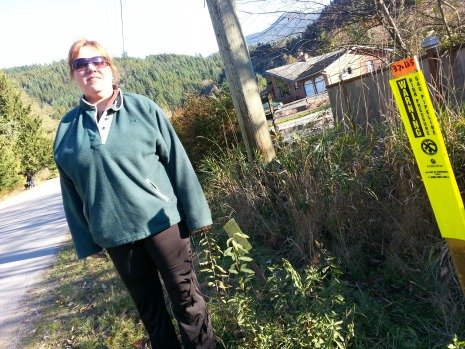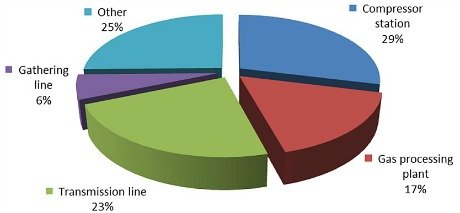
By Gagandeep Ghuman
Published: Dec 13, 2014
Kerry Brown is the first one to admit that accidents are rare for compressor stations. But when they happen, they can be catastrophic, he says.
Brown’s family lives in Dentville within the 800 metre radius of the proposed compressor station that will pump gas to the Woodfibre LNG.
The compressor station is in the Business Park on Government Road next to the Blacktusk Storage, an empty lot used for parking during the Olympics.
Brown said he has asked FortisBC at least twice on their evacuation radius but they have ignored the question. The Fortis community representative noted their concerns in an official meeting, but never responded.
“They avoid public input and it seems like they are trying to hide something,” he said.
Brown said in an early map he saw, Fortis was planning to put the compressor station on Watts Point. Cost saving is the only reason why Fortis is putting the compressor station in the business park.
“I admit that this is a very safe operation, but would it be safer outside the populated areas,” he said.
Carol Greaves, media relations officer with Fortis, said the company has offered to purchase the land at the intersection of Industrial and Queens Way, but the offer is contingent on approvals.
She said Fortis looked at several sites but selected the present site because there were environmental and zoning issues with other locations.
“We own operate 11 compressor stations and we have never had an incident,” she said.
Graham Currie from BC Oil and Gas Commission said the minimum distance between a compressor station and any residential subdivision is 100 metres. He said the commission hasn’t yet received an application for this site, but it’s expected that the proponent will meet the necessary regulatory requirements.
There have been four major incidents, according to BC Oil and Gas Commission.
Nov. 2007 – Gas release due to leaking valve. Valve was closed and repair made.
May 2008 – Fire from a flare caused a grass fire that could have threatened a compressor station. Fire was contained and extinguished.
Oct. 2008 – Vandalized pipeline caused a small leak in a flange at the compressor station. Line was depressurized and repaired.
Oct. 2008 – A well feeding a compressor station caused over pressuring that resulted in a valve failure. Well was completely shut down and repairs made.
Pipeline concerns in Squamish
Fortis is also planning to twin its existing natural gas pipeline from Port Coquitlam to Squamish. The new pipeline, 24 inch thick, is expected to deliver 228 million cubic feet of gas every day to Woodfibre LNG.
For citizens like Herbert Vesley, the gas pipeline old and the proposed new pipeline will pass too close to home.
Vesley lives just 60 feet from the old pipeline and is concerned about the new pipeline being proposed. He wrote to the EAO in Victoria who told him there is no regulation on how far the pipeline should be from a home.
“In BC, there are no defined setbacks on residential areas, wrote Dan Motisca, a project assessment officer with EAO.
Vesley said the Gas Research Institute specifies a hazard setback of 660 feet for a 24-inch pipeline.
“What alternative routes that would avoid urban areas have been considered by Fortis,” he said.
Another resident, Hans Schaer, said he is concerned about shut-off valves on the pipeline, but Fortis hasn’t shared that information.
Fortis spokesperson Greaves said the shut-off valves are proprietary information of Fortis. She said the valves can be turned off manually and automatically. She claimed the recent compressor station incident in Saskatchewan happened because the station lacked shut off valves.
Eleven pipeline accidents were reported to the Transportation Safety Board of Canada in 2013, up from a total of seven accidents in 2012.
According to a CBC database, British Columbia experienced the most pipeline safety incidents for a single province, with 279 recorded events from 2000 to 2012 in the data set. Alberta came in second with 244 incidents, followed by Ontario with 146.
Fortis is applying for an EAO certificate in the next few weeks, and hopes to start construction in late 2015.





Tjay says
Even more hypocrites …. Sure WEEEE can use it…. but no one else can… pffffft Go away !!
Jean says
Any private company potentially able to harm occupant attendants or users or infrastructure such as Ski lift for instance, are required to report to the authority as per regulations set out to protect the public from its operational safety and accident or incidents records and they are publicly filed and readily accessible to see by the public at any time, how ever neither the BCUC or the Oil and Gas Commission is mandating Fortis for instance to answer to public inquiries about safety and or potential harm.
As the OGC according to there set of rules has a rule 37 whereby mandating anybody knowledgeable or suspecting a shortfall or potential disaster in waiting to report it. I have and by registered letter and follow up to the OGC still after month not received any acknowledgement or dialogue and as to safety valves it is no secret as to what a good functioning safety valve should provide, easy to google etc. but Fortis obviously after having installed on there Squamish line over 20 years ago what was acceptable at that time does not mean, that we should not upgrade if there is a better product available and the fear is obviously that they don,t want to admit that they have antique equipment on there lines falling back on the acceptability of it at one time, meaning it is acceptable for ever. In the same talking OGC does not at all serve the public by not insisting that it should be made public and if more advanced technology is available that would prohibit an accident like San Bruno California, killing 8 people destroying 38 houses and not able to shut off the gas flow for over 90 minutes. Is it acceptable for us to say that this then it will never happen to Us we are Canadians!!!
Also the US having evacuated in a radius of 1500 ft every body with the same size of a pipeline showing some problems, obviously should alarm our regulatory agencies, that we should follow suite and consider new save distances from Gas pipe lines and as it is mandated to this date, that Fortis should have vented gas pipes under Highways and Railroads, much more should it be mandated in this day and age, that any Gas pipe line at least should follow new regulatory attempts suggested by the Research Gas Institute, suggesting to invoke a save no kill distance from any gas pipelines especially in new ones to be constructed, with the state of the art shutoff valves available today and also casing with venting in addition, also for all gas lines new or old passing trough and under populated areas, wedder new or established and with it, established even so claimed as grandfathered, to be cased as in accordance with new safe kill zone distances and avoid potential disasters that where estimated in the billions of Dollar as in San Bruno Ca. Why is it so hard to get those messages across and or would it be maybe time to publicly address it and make the owners and government and regulatory agencies aware, Just like a neighbours tree hazard if notice given, such neighbour would be liable, that in case of an incident or accident on gas lines, after notification by the public, it would recommend that the agencies and the head of such agencies should personalty be held criminally responsible, with the full brunch of the law. It is not fear mongering, it is realistic calculation of potential harm in the waiting.
Cinci Csere says
Absurd. I live in Dentville too! LNG is not welcome.
Larry McLennan says
Jean- have you actually read what happened in the San Bruno accident? First off- the pipeline was built in 1956- ie it was abot 54 years old and, as it turns out ,had faulty welding which shouldn’t have even passed inspection in 1954. The company (PG & E) failed to detect any problems over the years and had, in fact, sub-standard safety procedues pretty much across the board. The explosion occurred when a electrical switch failed and resulted in a slight increase in gas pressure. It was the small pipes (called pups) which were inadequately welded in the first place which ruptured. No automatic shut-off valves were in place along the line and, incredibly for California, the state had grandfathered all gas lines installed prior to 1970 to not be subject to water-pressure testing. Yes, it doesn’t make sense to me either. Another salient note pertaining to PG & E management is that they (management) had paid themselves generous bonuses from- wait for it- funds set aside for the maintenace and improvement of the pipeline. In short, the San Bruno pipeline was woefully mismanaged by PG & E and ,as it turns out, not really inspected to any degree by the state government. Conversely, here in BC (and across North America) much higher standards are in place especially when compared to 1956. Pipeline welds are X-rayed for quality determination. Shut-off valves and other safety features are are manditory and government agencies regulate what standards must be met in order to build the pipeline ( California , in 1956, had no government regulation w/r gas pipelines) . Current safety standards in BC are very high and comparing the dangers of the San Bruno accident to today’s pipelines is somewhat stretching the issue. I refer mostly to the San Jose Mercury News article by Steve Johnson, Pete Carey et al. You might give it and other articles a read.
Herbert Vesely says
It is always a multiplicity of errors/omissions that lead to the catastrophic accidents – take for example the failure of the US space shuttles – it is never just one thing! So in future it will be another combination of circumstances that lead to a major accident of a gas pipeline. It is for this reason that the Gas Research Institute and C-FER Technologies 2000 specify a hazard setback of 660 feet for a 24 inch pipeline.
You might give these items on Wikipedia a read “List of pipeline accidents in the United States in the 21st century” http://en.m.wikipedia.org/wiki/List_of_pipeline_accidents_in_the_United_States_in_the_21st_Century.
and Canadian accidents at http://en.m.wikipedia.org/wiki/List_of_pipeline_accidents.
JohnS says
And what happens when the demand for BC natural gas plummets because China has developed their own reserves and are piping it directly from Russia with the recently signed agreement. Guess what – gas pipelines can be, and are being, easily converted to carry oil:
http://business.financialpost.com/2013/02/15/enbridge-profit-falls-plans-to-convert-gas-pipeline-to-ease-crude-glut/
http://www.transcanada.com/energy-east-pipeline.html
Sounds like a pretty easy way to get tar sands oil to the coast don’t you think ?
If more people knew this, I am sure there would be a lot more opposition to this project. I doubt anyone in town would want to risk an oil spill in Howe Sound.
Larry McLennan says
Johnny, it may calm your heart to learn that, apparently recently, the B C Government , has specifically prohibited gas pipelines from being used to carry oil .
Dave Colwell says
And Larry, we all know how water-tight that is! or it it oil-tight?
Jean says
Well said Dave,
Remember Tumbler Ridge and all the other promises and laws made and then changed
Larry McLennan says
List them jean